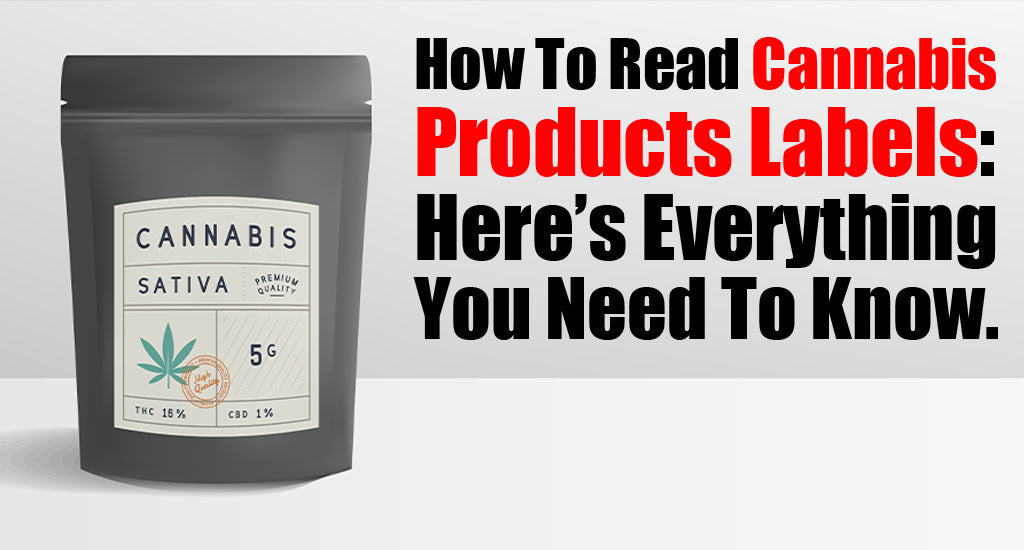
How To Read Cannabis Products Labels: Here’s Everything You Need To Know
DO LABELS MATTER ON CANNABIS PRODUCTS?
Cannabis labels are designed to educate you about the product you're about to consume—at least, they're supposed to do that. Theoretically, without accurate labels, it would be challenging to know what you're putting in your body. But, with anywhere from 700 to 3600 strains out there, labels are becoming less and less informative.
There are a plethora of strains out there, so learning how your body reacts to different kinds of cannabis can be more beneficial than relying on a label to tell you what you'll feel.
For example: I find that Sativa-heavy strains can sometimes make me sleepy, even though the labels say I should find them energizing. Why?
Well, there are a lot of things that make a product unique, such as terpenes, cannabinoids, THC/CBD content, and how you plan to consume your product. It's also important to keep in mind how the different cannabinoids work together to create the 'entourage effect.'
Being aware of these factors can be more important than simply looking at the Sativa versus Indica label, which makes them increasingly irrelevant in this day and age.
WHAT'S THE DIFFERENCE BETWEEN SATIVA, INDICA, AND HYBRID STRAINS?
Strains of marijuana are traditionally divided into the categories of Sativa, Indica, and hybrid.
Sativas are associated with high energy, productivity, and a head high. They're generally thought to be uplifting and creativity-inducing.
Indicas are more relaxing, inducing a body high and occasionally couch-lock. They're good for sleep and getting the munchies.
Because of the ever-growing industry, most strains today are hybrids, a blend of Indica and Sativa.
It's pretty tough to find a strain these days that's pure Indica or pure Sativa, which makes labeling difficult and often inaccurate. However, labeling strains as Indica-like or Sativa-like can be a more accurate way to describe the product and help users predict what their high will be like.
HOW DOES THE CANNABIS INDUSTRY CLASSIFY STRAINS?
Determining how a strain gets labeled is a specific scientific process, and admittedly, I'm no scientist. But here's the abridged version of the whole process:
Growers will typically look at plant parentage to create a label. Are the plant parents Sativa-dominant, Indica-dominant, or a mix of both? Again, keep in mind how varied hybrids can be—this can be a tricky process, and it's not always black and white!
Sometimes, if it's hard to determine, growers will look at the grandparent plants. This can help, or it can make the process more confusing. This is why it's more important to look at other factors, rather than simply the name of the strain.
If looking at parent/grandparent strains is a no-go, then growers will test the strain. They'll have a bunch of people try it and give feedback to come up with a semi-accurate label.
ARE SATIVA/INDICA LABELS ACCURATE?
The answer to this question is simple: no.
The labels in the industry initially classified strains by the effects they have on the user. Once the trend caught on, it became a basic way of understanding and classifying strains. However, labels can be subjective, and it can be hard to trust them.
As hybrids become more popular, they are bred with other hybrids, which alienates them further from their parent plants (or, as time goes on, grandparent plants). The more generations we get, the further away from pure Indica or Sativa we get, which makes labeling them as Indica or Sativa impossible.
With so many hybrids, it's entirely possible that a plant more closely related to a pure Sativa may have more dominant Indica-like characteristics or effects, and vice versa. This makes it confusing for buyers to understand which labels are attached to strains and why.
In a study of nearly 300 samples, researchers proved strains considered Sativas and Indicas do not typically share all the expected traits of the category, and even those sharing the same labels are often very different.
HOW DO I CHOOSE THE RIGHT CANNABIS PRODUCT AT MY LOCAL DISPENSARY?
If labels aren't trustworthy, how are we supposed to choose the right products?
The answer to this is also quite simple: look at the other descriptions of the product.
It's important to consider the strain you're consuming, of course, but it's even more important to consider the other factors. Here are some of those factors:
-
Levels of Various Cannabinoids: The levels of various cannabinoids can affect the type of high you experience. Some compounds are more psychoactive, like THC, THCV, and CBN. Some are less psychoactive, like CBD, CBG, and CBC.
-
Chemical Varieties (Chemovars): Different chemovars influence highs. Strains can be high THC (type I), THC and CBD combined (type II), or high CBD (type III). Depending on these levels, a strain gives a different high.
-
Terpenes: Terpenes, responsible for flavor and odor in plants, can also affect the high experience. Some are known to reduce pain, while others can help improve your mood. The most common terpenes are limonene (citrusy), myrcene (spicy/earthy), pinene (piney), and linalool (lavendery/perfumey). Think of what you like to smell—if you hate the smell of lavender, don't choose a product with linalool!
-
Time of Harvest: The time of harvest can change levels of cannabinoids and terpenes. Early harvest can result in lower levels of some cannabinoids and terpenes, while late harvest can have much higher levels or be too strong for the average user. Ask your budtender if they know when your product was harvested.
-
Proper Storage: Proper storage can also impact the potency of your product. To prevent loss of potency, keep your weed in a glass jar in a cool, dark environment!
-
Method of Consumption: The method of consumption also affects the kind of high users experience. Today, marijuana can be consumed by smoking, vaping, eating edibles, taking tinctures, mixing it into drinks, using suppositories, and using topical lotions/ointments.
Each of these methods can affect which part of the body absorbs or metabolizes it first, how concentrated each of its compounds are, and how quickly the effects begin. Side note: we don't really recommend edibles for first-time users, so keep that in mind!
QUESTIONS TO ASK WHEN PICKING A CANNABIS PRODUCT AT THE DISPENSARY
That was a lot of information, so let me simplify it for you. Here are some important questions to ask when picking a product:
- Do you want high or low energy?
- Would you rather feel sleepy or alert?
- Is pain relief important to you?
- Do you want to feel relaxed?
- Will you want to be productive?
- Do you want a mood booster?
- Will you want the "munchies" or other appetite changes?
Narrowing down which effects you want to experience or avoid can help you find the right product for your activities. However, remember all bodies metabolize marijuana differently, and the same strain can impact different consumers in a multitude of ways.



